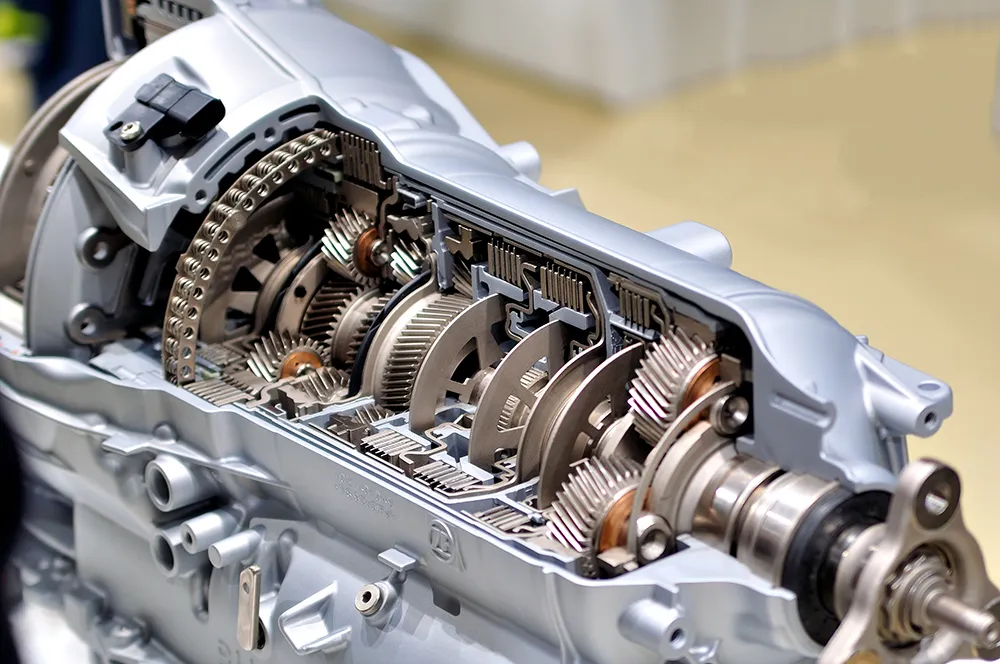
Have you ever wondered how your engine makes your vehicle’s wheels move? Your transmission plays a part.
In a vehicle, the transmission is responsible for converting energy into power for your wheels. It also helps your car change gears so it can function properly at different speeds.
How a Transmission Works
Some vehicles have a hydraulic planetary automatic transmission, which is a fancy way of saying it’s an automatic transmission. Other vehicles, including the first cars ever introduced, have manual transmissions that require a bit of finesse to change gears. Our Bountiful car repair team will take a dive into how both types of transmissions work but, first, let’s get a general idea of the function of a transmission.
Parts of a Transmission
Whether you’re driving an automatic or a manual, your transmission contains a number of parts to reduce the power generated in the engine.
- Gearbox
- Gears
- Gear trains
- Drivetrain
- Clutch
- Crankshaft
- Prop shaft
- Differential
- Final driveshafts
Engines operate at high speeds, which doesn’t translate well for your car’s wheels; they need to be able to start, stop, speed up, and slow down. A transmission reduces high engine speed to a more appropriate level, which in turn increases your vehicle’s torque. Torque is the twisting or rotational force of your vehicle, and the higher it is the better your car accelerates.
The gears and gear trains housed in the gearbox allow a vehicle to change speeds, and also move between forward and reverse motion.
Types of Transmissions
A manual, or stick shift, transmission is one for which the driver is responsible to change gears. An automatic transmission is one that does the work for you, automatically changing gears at the appropriate speed.
Manual Transmission
A vehicle with a manual transmission has a clutch pedal for the driver to engage with his or her foot while in motion. When the clutch is depressed, the driver manually moves the gear shift, usually located between the two front seats. Once in the desired gear, the driver releases the clutch pedal back to its starting position. As you can imagine, these maneuvers can be tricky to master, and they made driving intimidating for many people.
Automatic Transmission
First introduced in 1934, the automatic transmission in a General Motors car changed driving. A vehicle with an automatic transmission automatically shifts gears for you, allowing the driver to keep both hands on the wheel, or one if the other hand is sneaking a snack. The goal was to make a car more accessible to all types of drivers, regardless of their aptitude with automobiles.
In an automatic vehicle, there’s an element called a torque converter that senses when your car is speeding up or slowing down; the converter lets the car know when to shift gears to accommodate your speed. Instead of needing to depress a clutch pedal in an automatic vehicle, there is instead a fluid coupling and a system to determine what gear your car needs to be in at any given speed.
Signs a Transmission is Failing
If your “Check Engine” light is illuminated on your dashboard, it could be related to your transmission. But since we all know that pesky light turns on for a variety of reasons, here are some other signs your transmission is failing. For Bountiful car repair, bring your vehicle in and we’ll read your engine codes to see if it’s your transmission or something else.
Problems Shifting
If you’re unable to get your car into gear or keep it in gear, it could be related to problems with the transmission. Whether you’re driving an automatic or a manual, it’s possible you just need to refill your transmission fluid or have the system as a whole looked at.
Burning Smells
If your transmission overheats, you’ll notice a burning smell coming from under the hood. It could also indicate that fluid is leaking and overheating in the engine compartment.
Noises in Neutral
When your car is parked and in neutral, you might hear strange noises. These can be a sign you need to flush and replace the transmission oil or take a look at the transmission to see if parts need repair. You might hear a grinding, clunking, whining, or humming sound (and no, it’s not the kids in the backseat).
Shakes
If your car shakes when you attempt to shift gears, it could be related to your transmission. Shaking is usually a symptom in cars with automatic transmissions, but it can also occur in a manual.
If you suspect you have a problem with your transmission, contact the Bountiful car repair team at Maser Muffler today.
Related Posts
As an EV owner, understanding your vehicle's battery is critical. From its capacity to its lifespan, and everything in between, we'll guide you through what you need to know to optimize your EV experience. So buckle up and get ready - we're about to shed some light on the electrifying world of EV batteries. What [...]
If your car is running hot, it can be a sign that something’s not right with your engine. Fortunately, diagnosing the cause of an overheating engine isn't too difficult if you know what to look for and how to address it. Keep reading if you want to learn the most common issues that occur when [...]
Your vehicle's exhaust system serves a critical role in managing the byproducts of the combustion process and ensuring optimal engine performance. The appearance of colored smoke from the exhaust pipe, either when stationary or accelerating, can provide valuable clues to underlying mechanical issues. What is a car exhaust? A car exhaust is a system [...]





